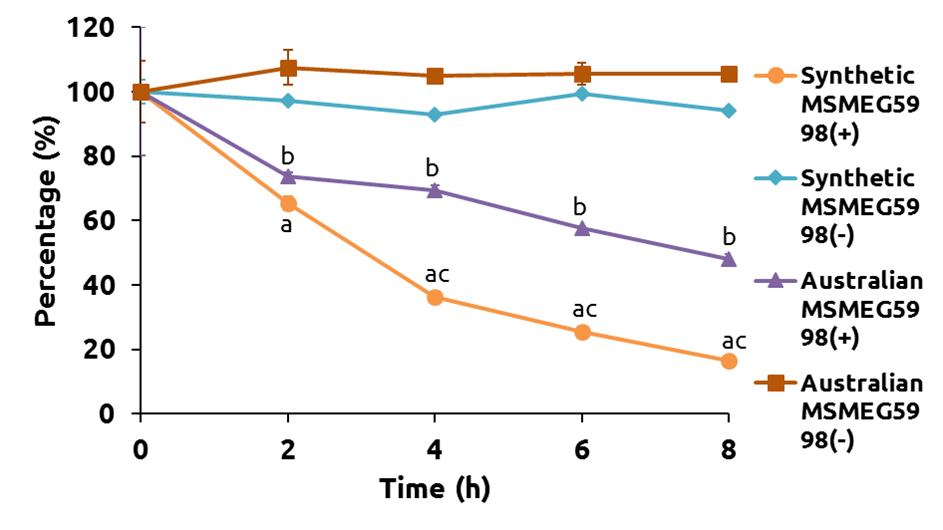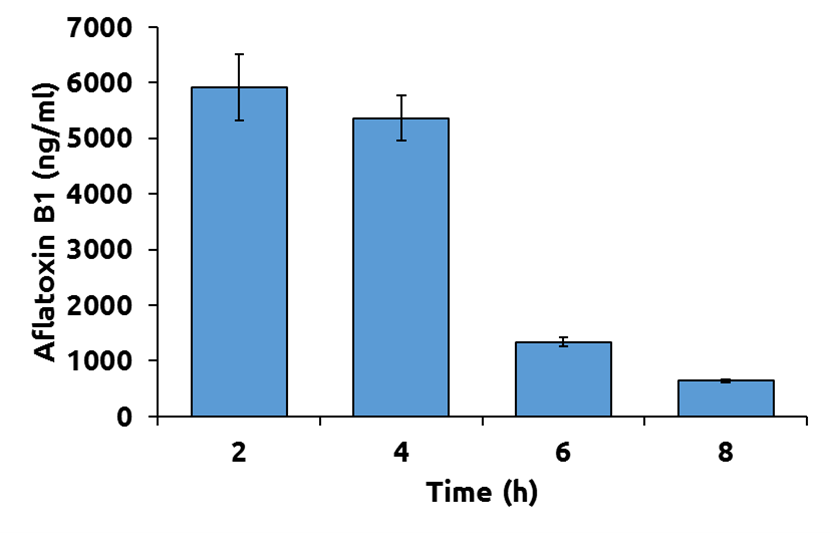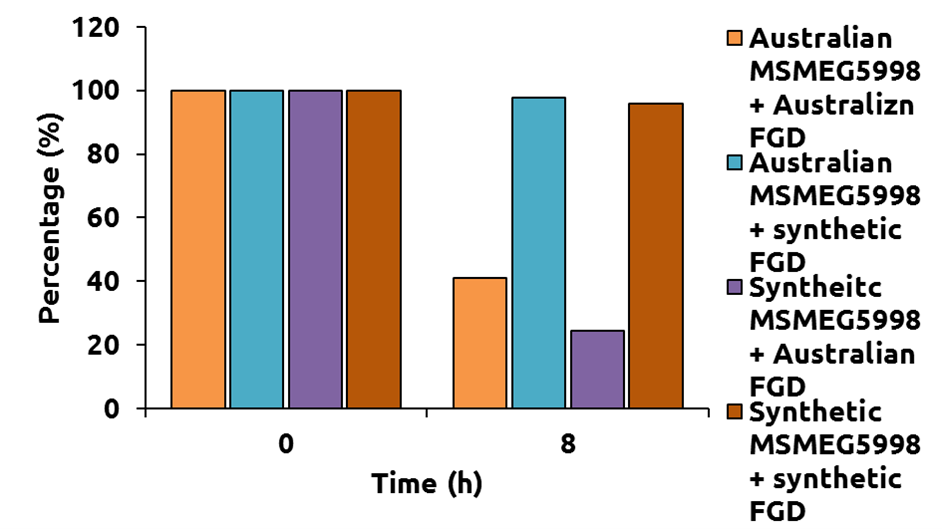Part:BBa_K2382002
F420-Dependent Glucose-6-phosphate Dehydrogenase
Sequence and Features
- 10COMPATIBLE WITH RFC[10]
- 12INCOMPATIBLE WITH RFC[12]Illegal NotI site found at 646
- 21INCOMPATIBLE WITH RFC[21]Illegal BglII site found at 695
Illegal XhoI site found at 961 - 23COMPATIBLE WITH RFC[23]
- 25INCOMPATIBLE WITH RFC[25]Illegal NgoMIV site found at 355
Illegal NgoMIV site found at 553
Illegal AgeI site found at 319 - 1000COMPATIBLE WITH RFC[1000]
Usage and Biology
The working condition of MSMEG_5998 includes the help from coenzyme F420. F420-dependent glucose-6- phosphate dehydrogenase (FGD) is the enzyme that reduces the F420 being used by MSMEG_5998 and make it available again.
Contents
Characterization of the F420-Dependent Glucose-6-phosphate Dehydrogenase
Expression results
IPTG induction
FGD ( plasmid is from Australia) was transformed into E. coli BL21 (DE3) strain to express our protein. Then IPTG was used to induce the expression system since all plasmids in our project had T7 promoter. We sonicated E. coli and did 9500 rpm and 13000 rpm centrifugation to remove the cell pellet and obtain the supernatant. To confirm the suitable concentration of cell supernatant, we did SDS-PAGE electrophoresis and coomassie brilliant blue staining. The results are demonstrated in the Fig. 1C. After centrifuging two times, we could find a high percentage of proteins in the cell supernatant (the 13000 Su group).

Protein purification, and dialysis
After extracting the cell lysates, we used nickel-resin column to purify our target proteins from the cell lysates because all of our proteins were tagged with 6 histidines at their C-terminal ends. After protein purification, protein dialysis with diaysis buffer containing 150 mM NaCl, 20 mM Tris-HCl (pH=7.5), and 20% glycerol to remove imidazole in our purified proteins, we did SDS-PAGE gel electrophoresis to ensure our target proteins were successfully purified (Fig. 2A ). The molecular weights of these proteins are listed in the Table 1. The standard BSA proteins were used to quantify the concentration of target proteins.
| Proteins | Molecular weight |
| Australian MSMEG5998 | 18.9 kDa |
| Australian FGD | 37.7 kDa |
Protein solubility analysis
To know whether the solubility of our two enzymes (MSMEG_5998 and FGD BBa_K2382002) increased after fusing enzymes with thioredoxin, we dissolved all cell lysates which containing pellet and supernatant and did western blot to detect the content of our target proteins. All proteins were detected by anti-6x His Tag antibody because all of them contained a 6-histidines tail when bacteria expressed them. In Fig. 3, we could find there was good expression of both Australian and synthetic MSMEG5998 in the “13000 Su” group when compared with the “13000 P” group. This result meant that most proteins were dissolved in the supernatant while few proteins deposited in the cell pellet after 13000-rpm centrifugation. However, we could not observe good solubility in both Australian and synthetic FGD because there were little or no difference between the “13000 Su” group and the “13000 P” group.
Enzyme Function Results
Enzyme Activity Assay
The conditions of reaction to degrade aflatoxin by MSMEG5998 were modified from Taylor’s study[6]. All concentrations of reactants are listed in Table 2 and 32 μM aflatoxin was used. We first mixed all reactants in eppendorfs and then put them at 22°C.
In Fig. 7A, we compared two proteins, MSMEG5998 and F420-dependent glucose-6-phosphate dehydrogenase (FGD) expressed from Taylor’s vectors (from Australia) and from our synthetic vectors. We found that both the Australian and synthetic MSMEG5998 have great activity and degraded aflatoxin B1 by more than 60%. The effect of the synthetic one may be better than the Australian one but there were no statistic significance.
| Name | Concentration |
| Aflatoxin B1 | 32 or 10 μM |
| MSMEG5998 | 0.1 μM |
| Reactants |
| Glucose-6-phosphate (G6P) | 2.5 mM |
| F420 | 5 μM |
| F420-dependent glucose-6-phosphate dehydrogenase (FGD) | 0.225 μM |
| Tris-HCl (pH=7.5) | 25 mM |
However, only Australian FGD has activity to reduce F420 into F420H2 and help the reaction. This finding corresponds with our dry lab results. Therefore, we used Australian and synthetic MSMEG5998 and Australian FGD to do the same experiment again to figure out whether the degradation percentage was dependent of time and whether the main reason of degradation was MSMEG5998.
</p>


The results were detected by direct 365 nm absorbance (Fig. 7B) and by ELISA (Fig. 7C). We found out that the degradation percentage was time-dependent. The synthetic MSMEG5998 had better activity than Australian MSMEG5998. The former was able to degrade 83% aflatoxin after 8 h while the latter could only degrade 52% aflatoxin.
References
(1)Taylor, M.C., et al., Identification and characterization of two families of F420H2‐dependent reductases from Mycobacteria that catalyse aflatoxin degradation. Molecular microbiology, 2010. 78(3): p. 561-575.
(2)Lapalikar, G.V., et al., F420H2-dependent degradation of aflatoxin and other furanocoumarins is widespread throughout the Actinomycetales. PLoS One, 2012. 7(2): p. e30114.
(3)Bashiri G, Rehan AM, Greenwood DR, Dickson JMJ, Baker EN. Metabolic Engineering of Cofactor F420 Production in Mycobacterium
smegmatis. PLoS ONE 5(12): e15803. doi:10.1371/journal.pone.0015803//cds/enzyme
//function/biosynthesis
| biology | Mycobacterium smegmatis |
| protein | F420-Dependent Glucose-6-phosphate Dehydrogenase |



